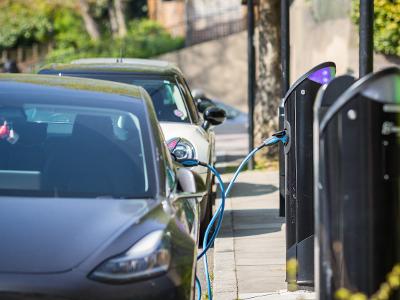Electric vehicle charging network plan greenlit by Cabinet
The road map for electric vehicle use in St Helens Borough has been set, as Cabinet approves a new charging network strategy following public consultation.

Article date: 25 January 2024
The St Helens Electric Vehicle Charging Infrastructure (EVCI) Strategy has been created to develop an inclusive, effective and innovative plan that will help residents, businesses and other organisations transition to electric vehicles, as part of a wider movement to a decarbonised, healthier transport system supported by walking, cycling and zero emission public transport.
This strategy covers the next five years but sets a framework for the council's role in the long-term, considering Government's announcement that 80% of new cars and 70% of new vans sold in Great Britain must be zero emission by 2030, increasing to 100% by 2035.
Approval of the strategy means that the council will now review the different types of EVCI for their suitability (pavement channels, lamppost charging, different types of on-street and off-street EVCI and high powered infrastructure) and develop an EVCI Asset Plan, mapping out potential future locations for charging points across the borough and the monetary support available through the Liverpool City Region Local Electric Vehicle Infrastructure (LEVI) Fund.
Adoption of the strategy follows a six-week public consultation and engagement roadshow last year, with feedback from residents and businesses informing the final version.
Respondents were asked what the biggest barriers are to purchasing or leasing an electric vehicle, and they identified the cost of electricity (64%), the cost of purchasing or leasing a vehicle (60%), followed by the ability to charge at home (52%), and the ability to charge away from home (51%) as the most important factors.
Many respondents commented on the current lack of existing EV charging points, with some respondents stating there are large areas of the borough without EV chargers and those that are available have long wait times to charge.
Councillor Andy Bowden, St Helens Borough Council's Cabinet Member for Environmental Services and Climate Change, said:
"In recent years, conversations about EVs between us as consumers and the public and private sectors often led to a chicken and egg problem. That is, should we adopt EVs without the necessary public charging network and thereby demonstrate the demand, or should the network come first to encourage the EV transition.
"We believe that we have a responsibility to play our part in the transition to EVs easier and more appealing, by working to deliver an inclusive and accessible charging network that offers good value for money, that contributes to a broader net zero transport network and supports economic growth as part of our Climate Action Plan."
Councillor Seve Gomez-Aspron, Cabinet Member for Strategic Transport, said:
"While it's the perception that electric cars are an expensive luxury, ownership is also increasing through company cars, mobility and disabled cars and other work schemes, and so it's important that we have an infrastructure to enable usage to grow.
"We know that a key barrier to the EV transition is currently a lack of charging infrastructure. It is needed at home, at key destinations like town centres, supermarkets, leisure centres and on route, with each requiring different power and charge time specifications.
"And given the scale of the challenge ahead to decarbonise transport, walking, cycling and zero-emission public transport must also be prioritised, with positive progress being made in this area including the adoption of our Local Cycling and Walking Infrastructure Plan to support active travel."
For more information and to view the strategy in full, visit www.sthelens.gov.uk/electricvehicles




